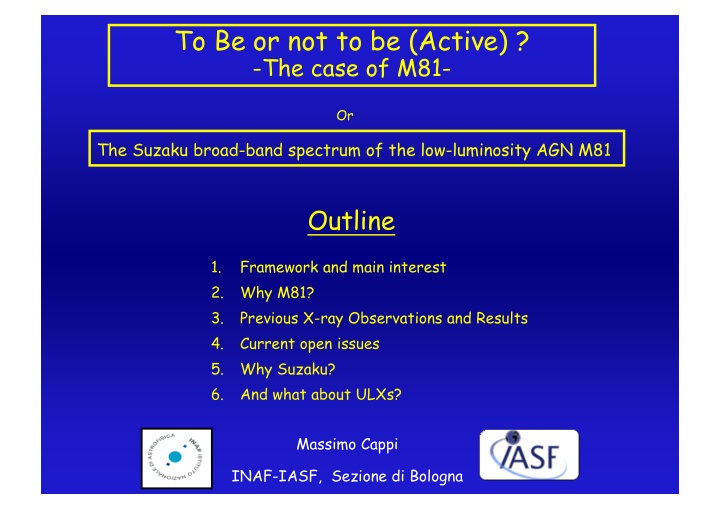



To Be or not to be (Active) ? -The case of M81- Or The Suzaku broad-band spectrum of the low-luminosity AGN M81 Outline 1. Framework and main interest 2. Why M81? 3. Previous X-ray Observations and Results 4. Current open issues 5. Why Suzaku? 6. And what about ULXs? Massimo Cappi INAF-IASF, Sezione di Bologna
Framework (i/iv): Last 10 years (after HST), a revolution: Most (if not all) galaxies host a supermassive black hole in their center Kormendy & Richstone, 1995, ARAA Richstone et al., '98, Nature M bh ~ _ 4 Magorrian et al. '98 (even co-evolution of BHs and their host galaxies… Tremaine '02; Gebhardt '02...etc feedback, etc.)
Framework (ii/iv): But only a few percent (5%-30%) of all galaxies are active ~5-10% of “high” luminosity AGNs (L>10 42-43 erg/s; L bol >10 -1 L edd ) ~10-30% of “low” luminosity AGNs (L~10 39-42 erg/s; 10 -3 <L bol <10 -1 L edd ) ~60-70% of “silent” (dormant?) black holes (L<10 38 erg/s; L bol <10 -3 L edd ) Ho, Fillipenko and Sargent, 1997abcd, 1998abcd N.B: L edd ~ 1.26x10 38 M/M sol erg/s The best of all examples: SgrA* Flare VLA Keck BIMA VLT Quiescence SMA L~10 36 erg/s and M~2.5x10 6 M sol --> ~10 -9 Ledd
Framework (iii/iv): Why some are active, and some are not? Currently several, many, accretion models: 1. Shakura-Sunyaev disk (SSD) or standard accretion disk(SAD) 2. Advection-Dominated accretion flow (ADAF) 3. Radiatively-inefficient accretion flow (RIAF) 4. Convection-dominated accretion flow (CDAF) And/or geometries 5. Slim disk 6. Truncated disk - advective tori (TDAT) 7. Non-radiative accretion flow (NRAF) 8. …and not to forget: jets! (Haardt '96) The big question is: Which (and when) is THE correct one? Read the excellent review by Andreas Muller (2004, PhD Thesis, on-line)
Framework (iv/iv): Currently “in vogue” picture Gracia et al., 2003 From the excellent review by Andreas Muller (2004, PhD Thesis, on-line)
Why M81? (aka NGC3031) Because it is the brigthest known LLAGN !! It is also: the nearest LLAGN (D=3.63 Mpc) Sab piral galaxy very similar to MW and M31 Compact nucleus detected, and well studied, at all wavelengths (from radio up to 100 keV) Mass estimate ~6-9 x 10 7 M sol F (2-10 keV) ~1-4 x 10-11 cgs, L 2-10 ~10 40 erg/s L bol ~ 2x10 41 erg/s, i.e. L/L edd ~2x10 -5 A scaled-up version of Sgr A* ? N.B: Also a one-sided VLBI jet
Previous X-ray observations: BeppoSAX (Pellegrini et al. 2000) Flux ~1-4 x10 -11 cgs PL up to 100 keV with Γ ~ 1.8-1.9 Ionized FeK line (6.7 keV) Ionized edge (8.5 keV) R<0.3 Overall is consistent with ionized absorber along line of sight + continuum from ADAF with strong Comptonization component
Previous X-ray observations: XMM-Newton (Dewangan et al. 2004, Page et al. 2004) 3 Fe lines at 6.4, 6.7 and 6.96 keV 2 Fe lines: one narrow at 6.4 keV and one photoionized plasma within 0.1 pc or non-thermal e- broad, ionized CRs with cold and hot ISM plasma Hot RIAF at r<100 Rg and outer cold No absorption edge (Tau<0.1) disk
Previous X-ray observations: Chandra (HETG) (Young et al. 2007) FeK α , and K β , narrow --> reflection from disk at r>55 Rg Some broadened (FWHM~1500 km/s) ionized lines, including FeXXV, from Hot collisional plasma at 106-8 K. Redshifted (-2560 km/s) FeXXVI component --> blob inflow, or inner outflow, maybe a jet
Previous X-ray observations: Other possibilities…? Matt et al. 1993
The (remaining) questions are: Origin of the Fe lineS? (Photoionization, reflection or ADAF?) Reflection component? Line and/or continuum component Jet component? Variability of one or more of the emission components? …and in general: how this relates to the general picture of LLAGNs?
Why Suzaku? Feb. 2000: Loss of ASTROE-I July 10th 2005: Launch of ASTROE-II August 10th: Loss of XRS calorimeter XIS (CCDs) and HXD working nominally (except for loss of XIS2 in Nov. 2006) Currently in AO-3 cycle (next round of proposals to be due end of November…) ⇒ The broad-band spectral coverage and sensitivity could be the clue to disentangle between the different physical interpretations (one clue could be to detect (or not) the reflection continuum component….)
The Suzaku observation: M81 was observed in 2006, May 8th Exposure Time: 100 ks XIS0,1,2,3 working nominally (at that time) PI : Prof. Makishima Data public since 2007, October 24th A ULX in the FOV? A significant contamination for the PIN spectrum? ⇒ The broad-band spectral coverage and sensitivity could be the clue to disentangle between the different physical interpretations (one clue could be to detect (or not) the reflection continuum component….)
Thank you for your attention… and let’s have a deeper look at the Suzaku data of M81 with some of you…
Recommend
More recommend